Watch back all our PMO Conference sessions
PMO Conference 2022 \\ The Secret to Driving Unstoppable Business Value for Your PMO – Laura Barnard

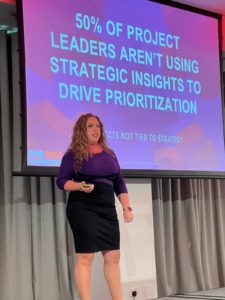 PMO Conference 2022, opening keynote session from PMO Influencer of the Year – Laura Barnard. Laura joined us in both London and Edinburgh to open the conferences and her energy and passion for the subject makes this an excellent session to watch to get your PMO mojo back or fire your imagination with what’s possible for your PMO.
PMO Conference 2022, opening keynote session from PMO Influencer of the Year – Laura Barnard. Laura joined us in both London and Edinburgh to open the conferences and her energy and passion for the subject makes this an excellent session to watch to get your PMO mojo back or fire your imagination with what’s possible for your PMO.
In today’s fast-paced, results-driven world, it’s not enough to define your PMO success by on time and on budget — you need to be great at making an IMPACT.
The truth is, if it’s not clear how you’re maximizing your company’s return on their investment, your role might be (incorrectly) labelled administrative overhead and they’ll start working around you to get projects done.
In this session, you’ll discover how to drive measurable business value quickly — so there’s no denying the clear-cut advantage you bring to the team. You’ll walk away with the road map you need to position the PMO as the strategic business asset necessary to lead your organization into the future and earn your seat at the table for good.
Session Recording
>>> Presentation Notes
>>> Worksheet
Session Notes
 Laura’s session focused on a number of different areas and in these session notes we take a look at the part where she advocates the PMO working across the entirety of the lifecycle of change – which starts with strategy and ideation.
Laura’s session focused on a number of different areas and in these session notes we take a look at the part where she advocates the PMO working across the entirety of the lifecycle of change – which starts with strategy and ideation.
If we look at a typical lifecycle:
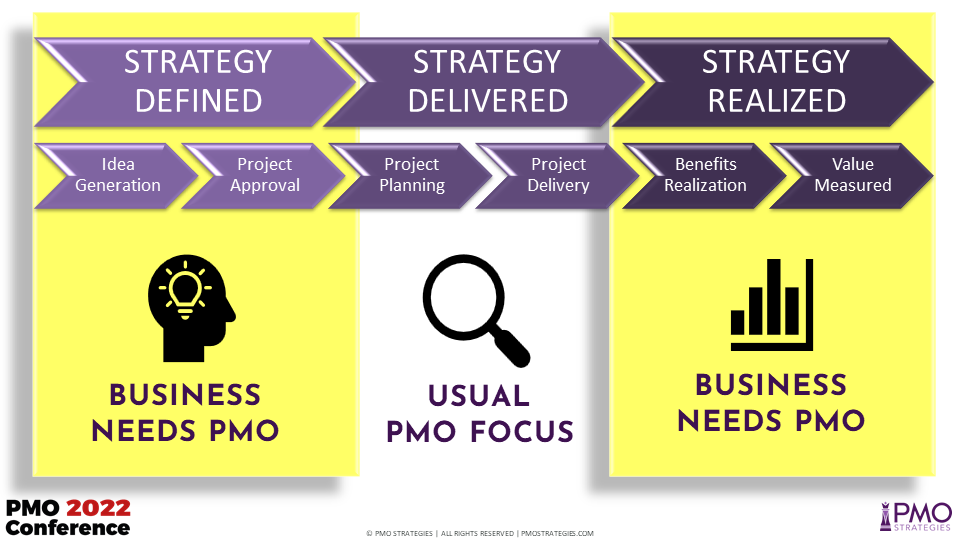
Laura talked about how the PMO tends to work mainly in the middle part of the lifecycle. The opportunity for the PMO is not just about doing that middle part well, it’s also about the left and right too.
It’s the strategy lifecycle that matters to a business – it’s the outcomes of the projects and programmes that ultimately contibute to a strategy being met, and that was one of Laura’s key messages for the PMO – help your business focus on delivering outcomes not just outputs.
The whole feel of the session was one about spotting opportunties – the PMO is in a prime position to extend where and how they support the business. To do that, the PMO has to understand how the entire strategy lifecycle works within their organisation and to understand where the problems are:

Within the session there were some practical insights – including root cause analysis techniques plus a worksheet to help you think about your own organisation and PMO.
Laura also gave some practical solutions to each of the three areas of the strategy lifecycle and how the PMO could get involved in helping their organisations do better.

Throughout the 2 day event, there were a couple of common themes emerging that PMO practitioners were either working on at the moment – or struggling with. These were portfolio prioritisation and defining success criteria. Laura mentioned both on the strategy definition part of the lifecycle.
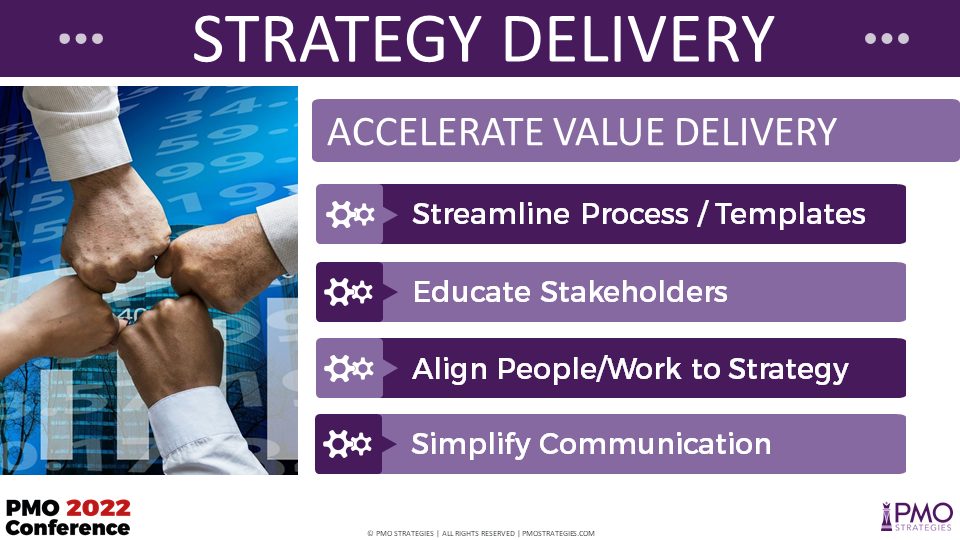
With the delivery part of the lifecycle, this was a call to action for helping our organisation deliver programmes and projects better. It’s where most PMOs spend their time and we need to ensure that we continue to look at where improvements can be made – if your PMO doesn’t have a continuous improvement cycle it will be in danger of being one of those PMOs that get disbanded after three years (that popular but often misquoted statistic that plagues the PMO world!)
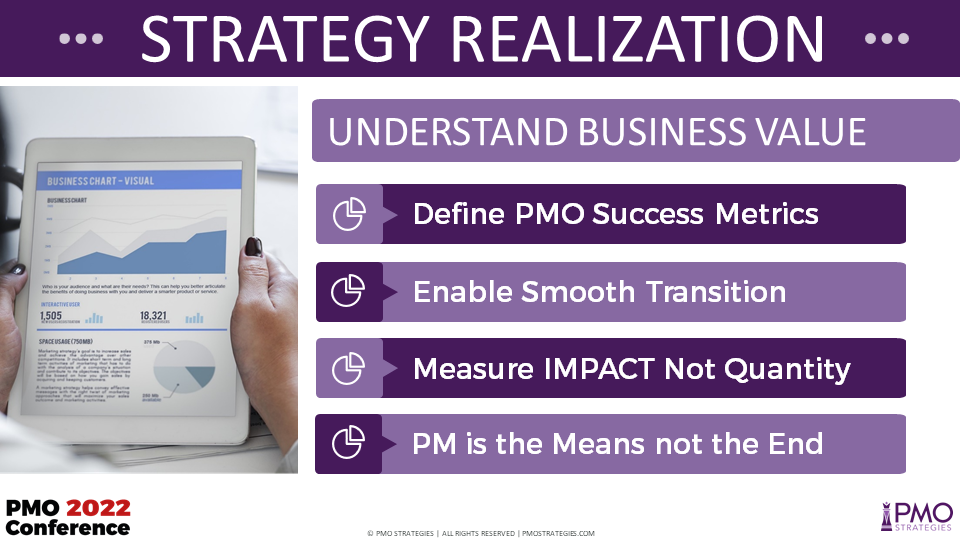
Finally, in the realisation part of the lifecycle, there must only really be one entity who can focus on this part. We all know that project and programme delivery teams are keen to move onto their next delivery opportunity; we also know that benefits (value) realisation suffers from no-one really being in the driving seat post-implementation. Isn’t this an opportunity for the PMO?
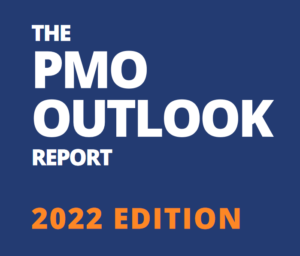
The session also covered some statistics from a recent report from Keyedin which you might find useful. Some of the challenge areas will look familiar so you can read a little more about the insights across these four. Interestingly with our own polls – we found that resource management also consistently came out at the top too. You can also read an Inside PMO Report about resource management here.
If you have any comments to make about this session, why not leave your comment below – we would love to hear what you think.
Session Overview from the PMO Reporter
Despite the long title, the simple message from this conference introduction was that, when fully developed, the PMO should be primarily seen as a key business asset, heavily involved in strategic planning and strategy implementation – rather than as just another administrative overhead.
To achieve this position, the PMO itself must develop, and then flex, its collective muscles (“muscles” in this case being the wholistic vision of the enterprise and its activities, that the PMO should have) so that it is seen as essential for the realisation of corporate strategy, and in doing so, make life easier for everyone involved.
Laura presented an array of statistics indicating the high level of personnel (executives to junior staff) that either don’t understand the corporate strategy or don’t act in conformity with it. This was associated with correspondingly high levels of project failures. She suggests that if the PMO was at the centre of program/portfolio/project planning, resourcing and scheduling, etc. (rather than leave these functions to individual PMs, department heads, line managers or admin staff working in relative isolation) then there could be greater coherency and alignment of corporate activities with the overall strategy or mission. This could reduce in-fighting, resource conflicts, and other unhealthy behaviours, and lead to much greater efficiency and hence business value. It would also ensure that the focus changes from the performance or outputs of the individual corporate elements, to the overall, integrated outcome of all activities.
Many thanks to Graham Gunn for this overview.

